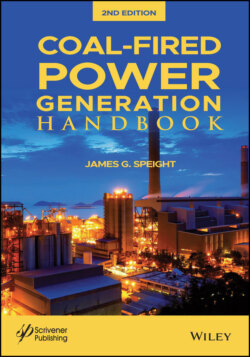Читать книгу Coal-Fired Power Generation Handbook - James Speight G., James G. Speight - Страница 103
4.4.2 Pyrite and Other Minerals
ОглавлениеSulfur, once considered a major factor, is now thought to be a minor factor in the spontaneous heating of coal. There are many very low-sulfur western subbituminous coals and lignite that have high oxidizing characteristics and there are high-sulfur coals that exhibit relatively low oxidizing characteristics.
However, pyrite (FeS2) evolves heat from aerial oxidation and was believed to be the cause of the spontaneous heating of coal. The heat generation locally promotes the self-heating process of coal but the reaction products have a greater volume than the original pyrite, with the result of breaking open any coal in which they are embedded and thus exposing a greater surface of coal to the air.
The interaction of pyrite (FeS2) with water and oxygen is also an exothermic reaction and results in the formation of iron sulfate (FeSO4) and sulfuric acid (H2SO4). Thus, if coal is stored in the open, rain will most likely increase the rate of this reaction and for the same reason water-flooding (to extinguish fires) may also increase the rate of the reaction.
Pyrite, through its transformation to bulkier materials, has also been cited as responsible in some cases for slacking and the resultant production of fines. For these reasons, coal users are generally reluctant to stockpile high-sulfur coal for extended periods of time (Berkowitz and Schein, 1951). However, stockpiling low-sulfur content of coal is no guarantee of safe storage – coal with low sulfur content can also spontaneously ignite.
Many minerals affect the oxidation rate to some extent, either accelerating or inhibiting it. Alkali chemicals are capable of accelerating the rate of the oxidation reaction while borates and calcium chloride can act as retardants of the reaction rate. The oxidation process is also promoted if ankerite [a calcium, iron, magnesium, manganese carbonate mineral of the group of rhombohedral-shaped carbonates, i.e., Ca(Fe.Mg.Mn)(CO3)2] is a constituent of the coal mineral matter. In contrast to ankerite, the presence of silica and alumina minerals tends to retard the oxidation reaction.
